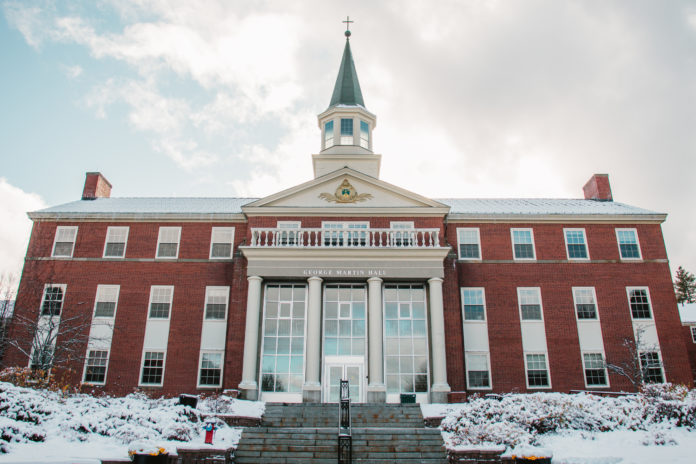
An award presented in error at St. Thomas University’s monthly Senate meeting on Jan. 19 sparked an equity debate among senators over the school’s large female student population in comparison to its male population.
Senate members voted down the McDougall Family Love of the Game Prize and the Hanif Brown Entrance Award because they were designated for non-equity-seeking groups, as both were proposed as awards for male university athletes.
Related: STU senate debates gender for awards, scholarships
But Jeffrey Carleton, STU’s associate vice president of communications, said the McDougall Family Love of The Game prize was never supposed to be presented at Senate because it didn’t fall under its purview.
He said Kim Fenwick, STU’s acting president and vice-chancellor, had the registrar’s office and the office of university advancement and alumni relations, which oversees STU’s awards, scholarships and bursaries, reviewed the files related to the McDougall family prize.
“[They] quickly came to the realization, when you look at the constitution of Senate, that this was a prize that had no academic requirements and, as such, did not need to go to Senate for approval,” said Carleton in an interview.
“It was an error, but it was one of habit or of omission of not following the constitution of Senate.”
In an email sent to Senators on Jan. 30, Fenwick wrote that varsity teams have a series of prizes, such as Most Valuable Player, which are not academic awards and don’t require Senate approval.
“These awards are presented to varsity athletes at the year-end Athletics banquet or similar event and are based on a coach’s or team selection,” she wrote.
But discussions at the Jan. 19 meeting found many senators raised concerns about equity.
Kristi Allain, chair of the senate nominating committee, called it “problematic” during the Jan. 19 meeting for STU to allow money from donors to be set aside for non-equity-seeking groups like men when the university’s predominate population is female-identifying.
“I do believe that it runs counter to the social justice framework that’s built right into our university,” she said at the time.
According to university figures provided by Carleton, September 2022 enrolment shows 73.2 per cent of students identify as female, 25.2 per cent identify as male and 1.6 per cent identify as other, which can refer to non-binary or gender-non-conforming students.
It differs from September 2013 enrolment, which showed 68.2 per cent of students identified as female and 31.8 per cent identified as male.
When looking at award statistics from the 2021-22 academic year, STU handed out 993 awards, scholarships and bursaries. Of that number, approximately 779 recipients were listed as female, around 201 were listed as male and about 11 were listed as other.
STU’s population that year was 1,794, according to numbers from the Maritime Provinces Higher Education Commission.
Martin Kutnowski, director of the STU fine arts department, spoke at the Senate meeting and raised his concerns from an enrolment standpoint about the low number of male students on campus.
“We need to take a really hard look at the absence of males on our campus and judge what we need to promote desperately,” he said at the time.
“In my own classes, the few males I have, I need to protect them because I’m going to lose them if not.”
Carleton said the number of female-identifying students attending post-secondary institutions has regularly increased over the last two decades.
Data analyst website Statista found 817,460 women enrolled in post-secondary education in 2000-01, compared to just 620,510 men. Those numbers significantly increased in 2020-21 to more than 1.2 million women, compared to 931,220 men.
It’s a growing trend that Carleton said governments and universities are monitoring continually.
“If there is a sector of our target audience that is undersubscribed, we will sit down and look to see if there are things that we can do to increase enrolment from those areas,” he said.
Margaret Campbell, an assistant professor in STU’s sociology department who teaches courses on women and gender studies, said higher education has historically been perceived as a male-dominated pursuit, but women have turned the tide.
Still, she wonders how demographic differences manifest outside of an educational environment, and if women remain expected to pursue university education more so than men in order to have a secure living.
“We see that more men will come into college or university, but then they’ll leave because there’s an economic opportunity for them … so those economic opportunities, are they coming to women in the same way? Perhaps not,” she said.
“If universities want to think about supporting students … it should be intersectional in its approach … we should be thinking about different groups of women and which ones are underserved.”
Many at the Jan. 19 Senate meeting endorsed the proposal of an award policy that doesn’t prioritize systemically-advantaged groups like men.
In her email to senators, Fenwick agreed there is a need to examine the equity issues raised during Senate.
“I will be asking the Registrar’s Office and Advancement to work with the Senate Admissions and Academic Standing Committee to review these issues as they relate to our policies or procedures for scholarship funding,” wrote Fenwick.
